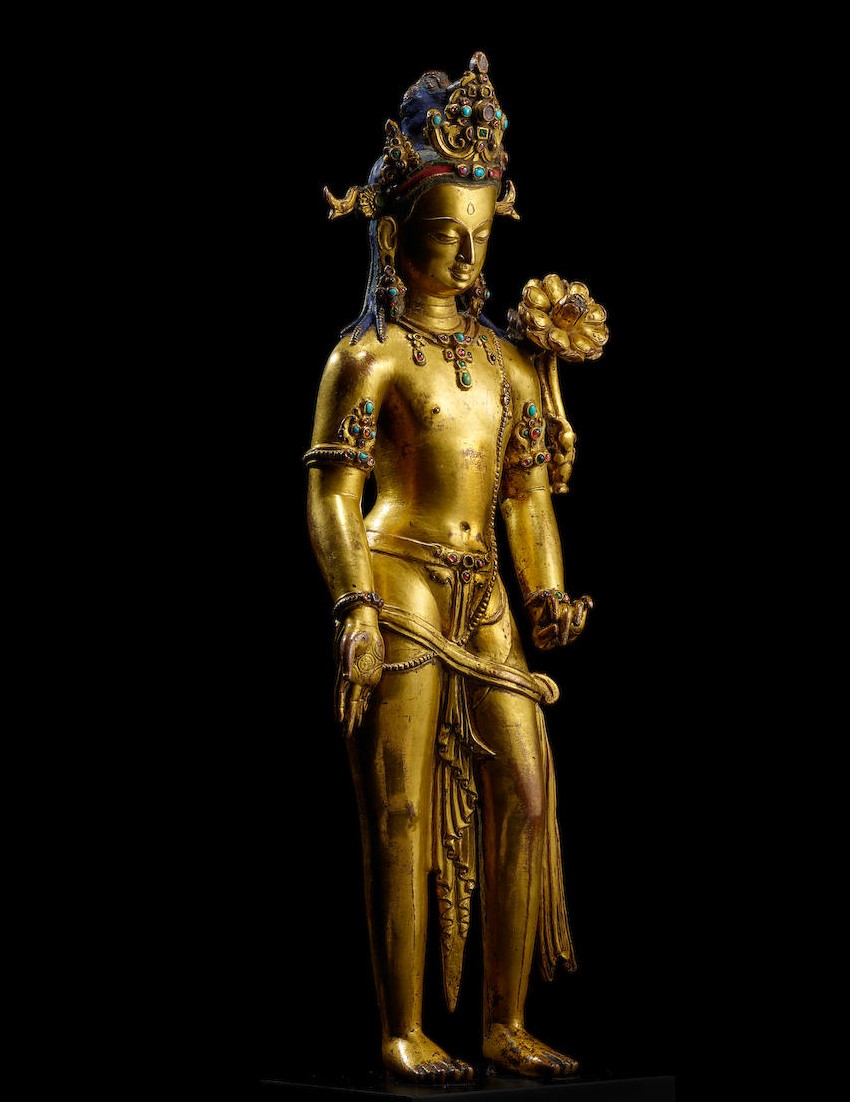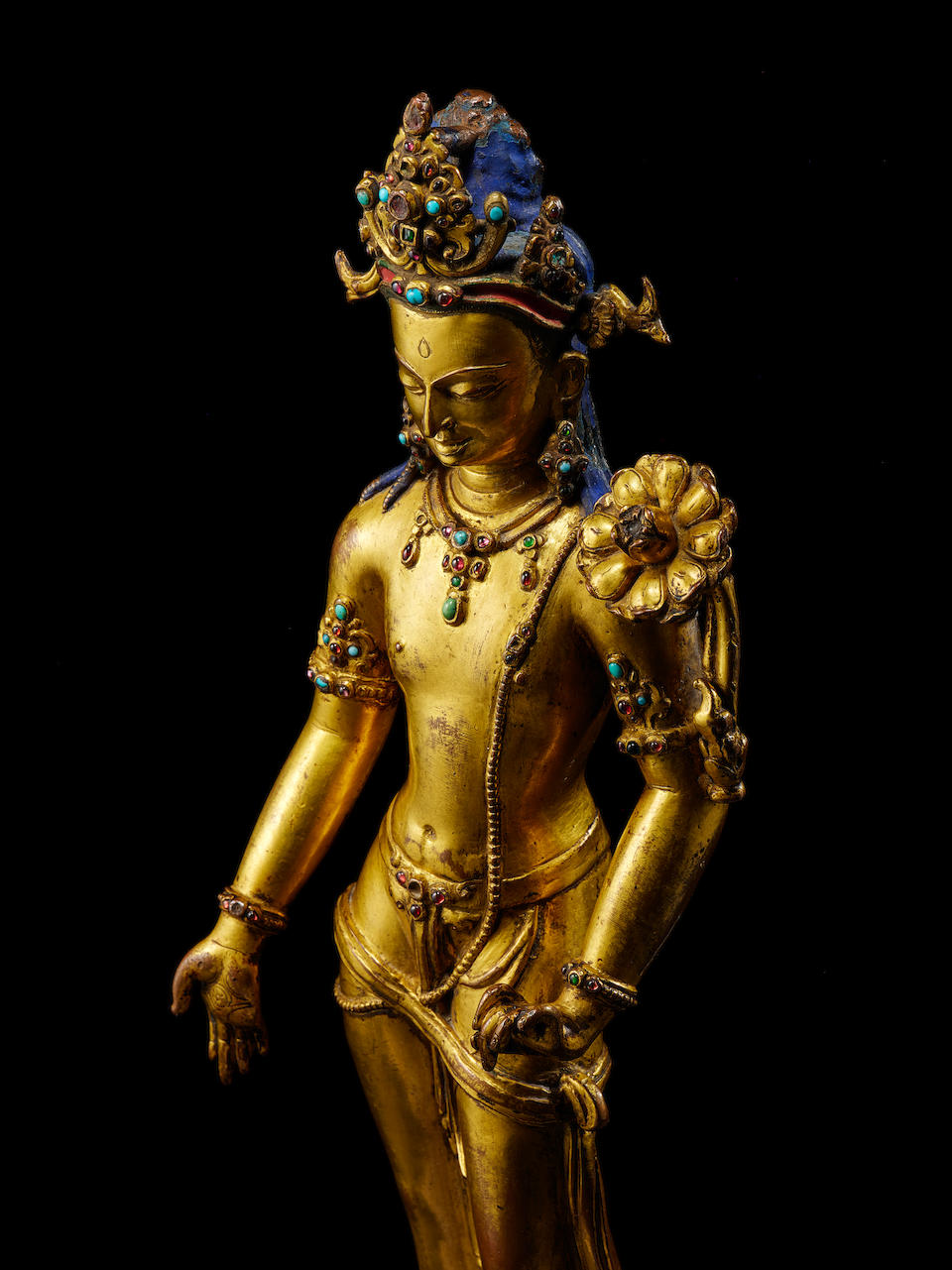Details
- Title : A GILT COPPER ALLOY FIGURE OF PADMAPANI LOKESHVARA
- Year : CIRCA 11TH CENTURY
- Classification : Sculpture
- Medium : GILT COPPER ALLOY
- Dimension : 39.5 cm (15 1/2 in.) high
- Accession No : GNM_LOT 7 Himalayan Art Resources item no.11839_BON_06
- Country/ Geo-location : Nepal
- Collection : Bonhams
- Status : Estimate: HK$ 12,000,000 - 18,000,000 US$ 1,500,000 - 2,300,000: 24 May 2021, 19:00 HKT Hong Kong, Admiralty
- Published : 1960-2000: Peter Marks Gallery, 40th Anniversary, 40 Selected Works, Peter Marks Gallery, New York, 2000.
- Provenance : Peter Marks Works of Art, Inc., New York Pierre Jourdan-Barry, Paris, acquired from the above in the 1980s Sotheby's, New York, 20 March 2001, lot 91 Private European Collection, 2002-2021
- Note : This lot has an impressive pedigree. Opening his gallery in 1960, Peter Marks (1935-2010) was a leading art dealer in the then-nascent market for Indian, Himalayan & Southeast Asian Art in the United States. Marks sold this lot to Pierre Jourdan-Barry, who handpicked one of the most sophisticated collections of Himalayan art ever formed in the West. The remainder of Jourdan-Barry's collection was acquired by the Rubin Museum of Art, New York, in 2005, and included many of the museum's masterpieces, including the 'Rubin Durga' (see HAR set no.1771). This elegant and impressively gilded sculpture depicts Avalokiteshvara, who is the bodhisattva of compassion and the most widely worshipped of the Mahayana bodhisattvas. Here, at the center of his forehead, the artist has depicted Avalokiteshvara's urna (considered a sign of a great spiritual being) not as the traditional tuft of hair, but as a confidently outlined teardrop gem, visually recalling the tear Avalokiteshvara shed for the universe upon surveying its suffering, and from which the bodhisattva Tara famously manifested to help. This symbolism is recalled by three teardrop pendants around Avalokiteshvara's neck. With the inset gems and turquoise stones against the bodhisattva's radiant skin, the artist draws the viewer's eye down across the sinuous physique he has cast. The eye traces the supple contours of the solar plexus and waist before being ushered by the sacred thread (yajnopavita) descending from the left shoulder over the sensuous sway of the right hip, and finally landing on the right hand which is outstretched in an iconographic gesture that signals Avalokiteshvara's charitable benevolence. Each finger is carefully articulated, and the open palm is incised with a wheel, drawing on an ancient concept of the bodhisattva as a chakravartin (lit. 'wheel-turner'), a ruler who protects and furthers the cosmic Dharma. The left hand would have held a thin piece of wire representing the stem of the lotus which rises and blossoms by his shoulder, affirming any being's ability to realize their innate Buddhahood, which is Avalokiteshvara's mission. The artist's detailed presentation of the flower is a casting tour de force saturated with nuanced symbolism, having plump, succulent petals suggestive of Buddhism's nourishing wisdom, while more nascent inner petals remain unfurled and support a setting for a gem, the fruit of Avalokiteshvara's ongoing work. Depicting Avalokiteshvara in his popular form known as Padmapani Lokeshvara, 'The Lord Who Holds the Lotus', this sculpture is a prime example of the Newari 'standing bodhisattva', which is one of Himalayan art's signature icons. The Newars are an ethnic group from Nepal's Kathmandu Valley renowned for being among the most accomplished artisans in Asia. They were frequently sought after for major artistic projects in Tibet, Mongolia, and China, and produced large, graceful standing bodhisattvas for domestic and Tibetan patrons most numerously between the 10th and 14th centuries. Representing the bodhisattva with an elegant, lightly-clad and bejeweled body accentuated by a sinuous 'thrice-bent' stance (tribhanga), the Newars preserved an artistic tradition established in India during the Gupta period (4th-6th century), regarded as India's cultural Golden Age. The standing bodhisattva's lithe physique and regalia draw on ancient Indic symbolism, which conveys the spiritual being's perfect inner consciousness through an idealized outer physique, cloaked in princely attire to assert his higher, spiritual authority over our worldly, political plane. While the Newars preserved the standing bodhisattva leitmotif from one masterpiece to the next, subtle shifts in detail and emphasis can be charted chronologically, leading to an attribution to the 11th century for this bronze. For example, as with a large, fragmentary standing bodhisattva in the Rubin Museum of Art, New York (C2003.24.1; HAR 65315), the mouth has a noticeably plump bottom lip, which Vajracharya argues is gradually abandoned after the 11th century, while the diamond shape of its earrings in fact appeared over the course of the same century (Vajracharya, Nepalese Seasons, New York, 2016, p.69). The yajnopavita on both the Rubin piece and the present example intersects with the slack sash around the hips in a manner which can be narrowed to the 11th and 12th centuries, neither looping up and over the sash like earlier Newari standing bodhisattvas from the 10th century, nor running parallel to it as is commonly seen in examples from the 13th and 14th centuries and beyond (see Bonhams, Hong Kong, 29 November 2016, lot 111, and the Rubin Museum of Art, New York [C2005.16.8; HAR 65430]; respectively). An 11th-/12th-century Padmapani Lokeshvara in the Metropolitan Museum of Art, New York (1982.220.2) similarly displays the bottom lip and intersecting sacred thread, as well as comparably wispy crown ribbons, foliate belt medallion, and diagonally-oriented sash. By the 13th and 14th centuries, noticeable stylistic differences include changes to the bottom lip and scared thread, as well the replacement of ring-shaped earrings, a less-prominent central crown leaf, more abstracted, slightly swollen thighs, and a general physique cast in a more exaggerated and thus more rigid standing posture, as seen in the later Padmapani Lokeshvara in the Rubin Museum of Art cited above. Therefore, in contrast to other standing bodhisattvas produced before and after, this outstanding Padmapani Lokeshvara benefits from a naturalistic and nuanced pose that more convincingly distributes the weight and balance of the thrice-bent stance. The figure is neither as stiff as more upright earlier examples, nor as exaggerated as later examples typically are—and neither attenuated nor plump. Rather, its portrayal of Avalokiteshvara's well-nourished form, which is a critical component of the idealized body within the Newari aesthetic, is understated and truer to nature. This 11th-century masterpiece is elegant in its moderation and shows a restraint in opulence more aligned with earlier Himalayan sculpture, drawing on ancient Indic visual modes that emphasize sublime authority through a supple, lightly-adorned body unencumbered by worldly toils.





